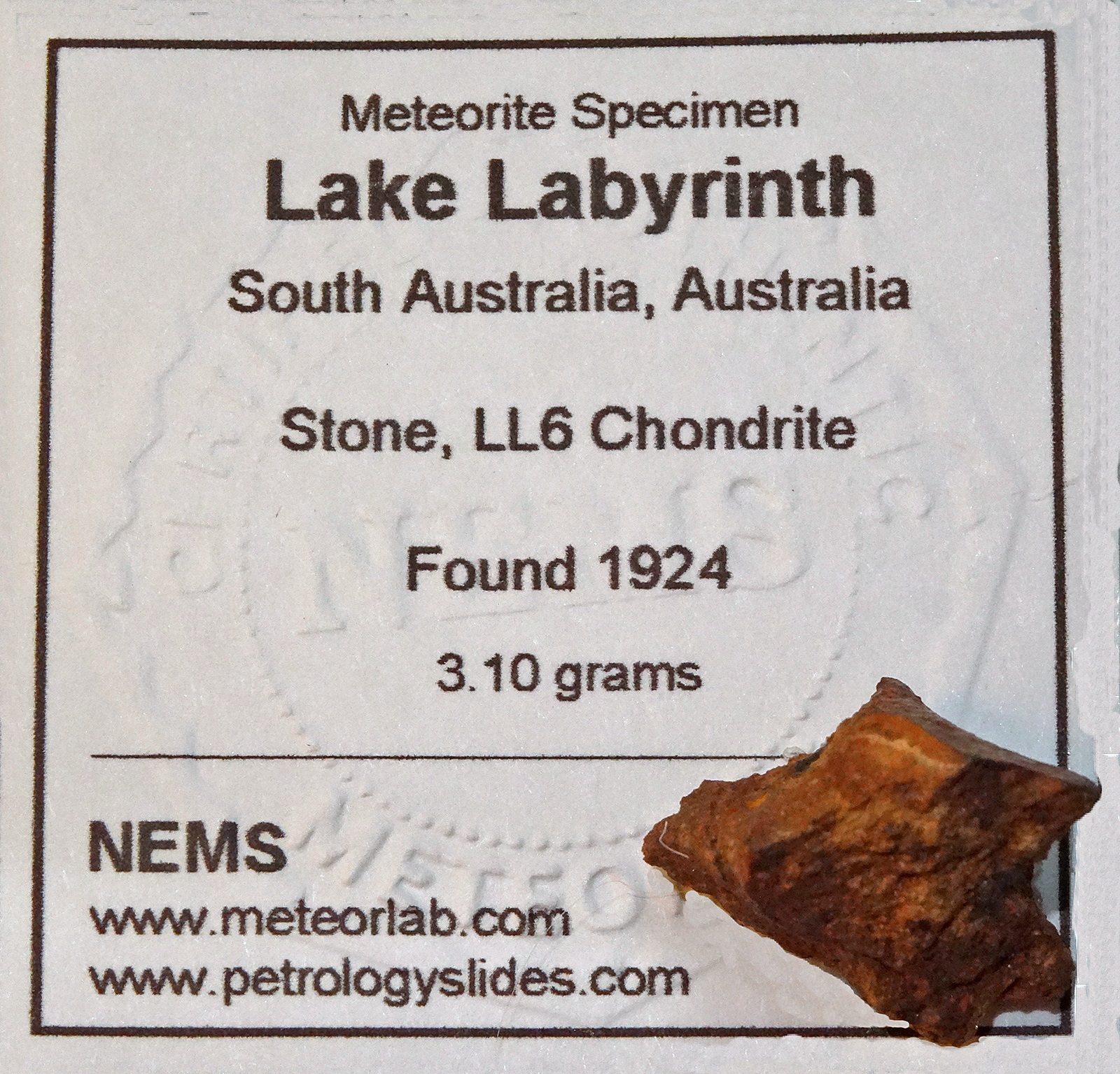|
Roll Overs:
#1
#2
|

|
3.1 grams. LL6
TKW 25.85 kg. Fall not observed.
Graham writes:
By L. J. SPENCE, C.B.E., M.A., Sc.D., F.R.S.
Formerly Keeper of Minerals in the British Museum.
[Read March 26, 1936.]
This stone was collected by Mr. R. Bedford in October 1934 'about
twenty miles north' of Lake Labyrinth. He gives the locality
more precisely as about eight miles north of Peela rock-hole and well
on the Wilgena sheep station, and the latitude and longitude as
approximately 30° 20' S., 134° 45' E. At his request it is described
as the Lake Labyrinth meteorite. Peela Well I have not been able
to find on any map available. Plotting the latitude and longitude
as stated, I find that the spot lies between Tcatree Well and Sextabyng
Wells, 1.27 miles NNW. of the western end of Lake Labyrinth,
and about the same distance north of the Trans-Australian railway
line. It lies north of the Warburton Range.
The following graphic account of the finding of the meteorite is
quoted from Mr. Bedford's letter of November 20, 1934:
I heard a rumour that a half-caste Australian aboriginal working at shearing
round that district knew of a meteorite up there, and the rumour seemed sufficiently
definite to justify our making the trip, a total distance of about 600 miles
by motor-truck. We were successful in finding the aboriginal, who proved to be
a most intelligent and observing man, his name Billy Austin. He had just been
shearing at Kukatha station, and was on his way to North Well, a section of the
great Wilgena station of 200 square miles area. He readily agreed to come
with us and show us the meteorite, from which we were then some 65 miles distant
by the station tracks. Billy informed us that a light and a rumbling noise
had been heard in the district on the night of about February 5, 1924, this date
being as near as he could remember. About a fortnight later, whilst travelling
on the station, he found, in the remote spot above mentioned, a hole in the ground
with dirt freshly scattered around ; bushes about were freshly burnt and scorched,
and at a little distance lay the meteorite, which was already commencing to
break up, one lump lying between the hole and the meteorite. Some time afterwards
he brought a piece to Mr. McBride, the owner of the station, who, he thinks,
took it to Adelaide ; and he showed the spot to a visitor from Mr. Gambler, who
took a piece. For the last six or seven years Billy had not revisited the spot,
and apparently no one else would be able to locate it without his assistance ;
and for these six or seven years no further attention was given to the find.
When we visited the spot we found the small crater to be at the foot of a red,
sandy rise; the vegetation was mulga scrub, sufficiently dense to make it impossible
to have located the spot without Billy's assistance, though he himself
walked onto it with perfect accuracy. Mr. Ken Peters, my assistant, who was
driving our truck, and is himself no mean bushman, was greatly impressed by
the way in which Billy guided us over the long, deviating route, often without
a track visible, without a moment's hesitation. The crater, when we saw it, was
a shallow, saucer-shaped depression 12 feet across, having been largely filled up
by washed and blown sand. We dug it out; it must have been originally about
4 feet deep in the centre; we confirmed Billy's assurance that no meteorite
material was present in it. The meteorite lay 30 yards west of the crater, up the
slope of the sand-rise. Billy, from his original observation, was of the opinion
that the meteorite had struck a glancing blow and then rolled on to the point
where it lay ; otherwise I should have thought that it had been blown out of the
crater by a back-fire.
Billy says that the surface [of the meteorite] was originally shiny, though it is
now dull, and that inside it was green. The less weathered fragments are still
greenish-grey, but weathered fragments are brown. The specimen is now so
fragmentary that it is impossible to reconstruct it entirely ; but it is clear that
it was originally a spheroid with diameters of 9, 8.89 and 7 inches. Part of the
surface was rugged, with smaller and deeper 'thumb-marks', while the rest was
more regularly spherical in curvature with wide and shallow markings. Allowing
for pieces that had been previously removed, the original weight of the meteorite
is estimated as about 75 lb. The actual total amount of the fragments recovered
is 57 lb. |
Click to view larger photos
#1
#2
|
Found at the arrow (green or red) on the map below
|
|
| |
Anne Black
12/10/2015 7:21:44 PM |
Thanks Graham for the documentation, it makes the meteorite even more interesting. |
John Cabassi
12/10/2015 6:39:03 PM |
Once again another nice one thanks mate |
Graham Macleod
12/10/2015 6:05:00 PM |
Hi Guy's,
Thanks again for your comments.
Larry I agree with you, If I read the document right it may have skidded and then landed where it was found?
So possibly not a round crater.
Cheers |
Larry Atkins
12/10/2015 8:04:04 AM |
A 75 lb meteorite made a 12 foot crater? Also, the original report mentions burnt bushes. Interesting! |
John Hope
12/10/2015 1:11:43 AM |
Thanks for photo's of another iconic Aussie meteorite Graham |
| |
|